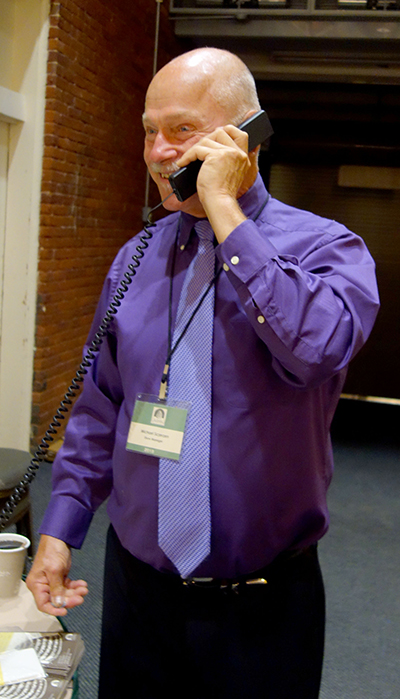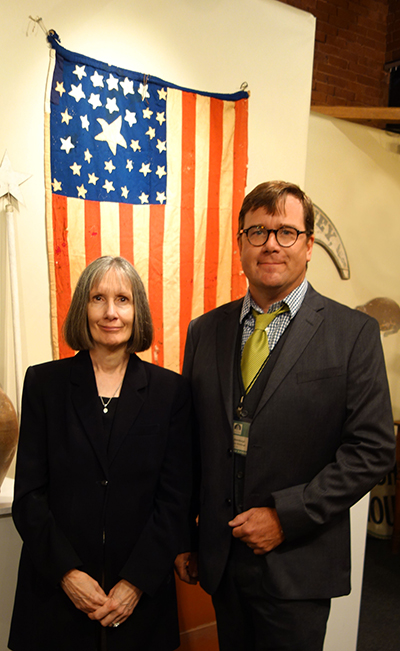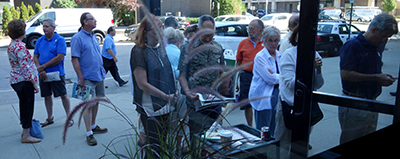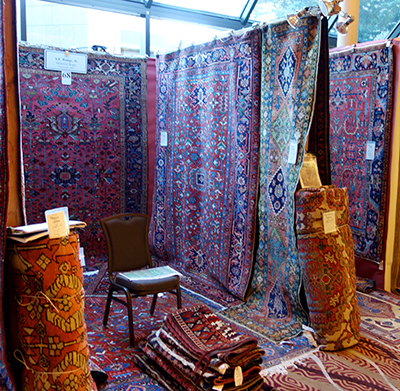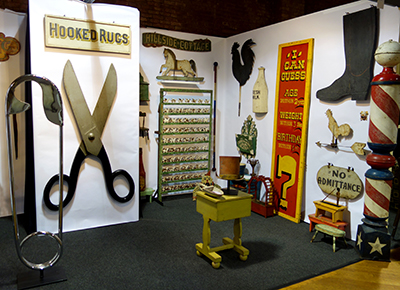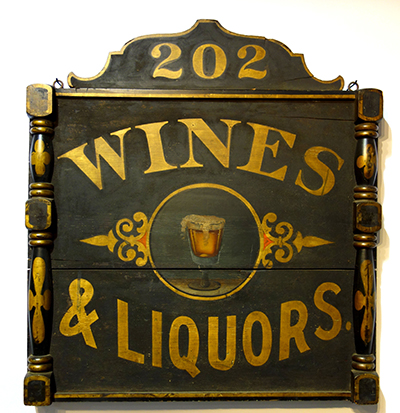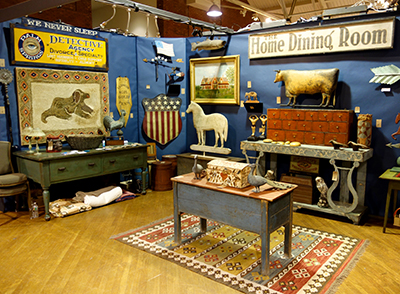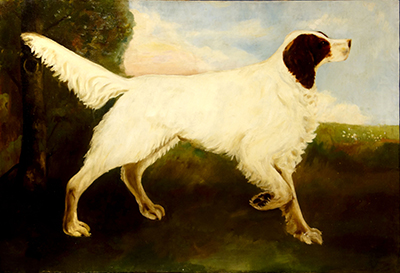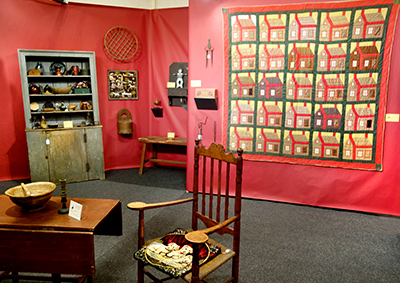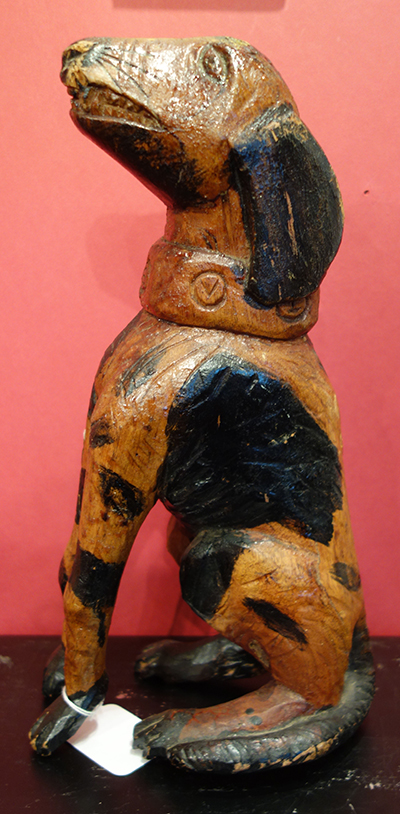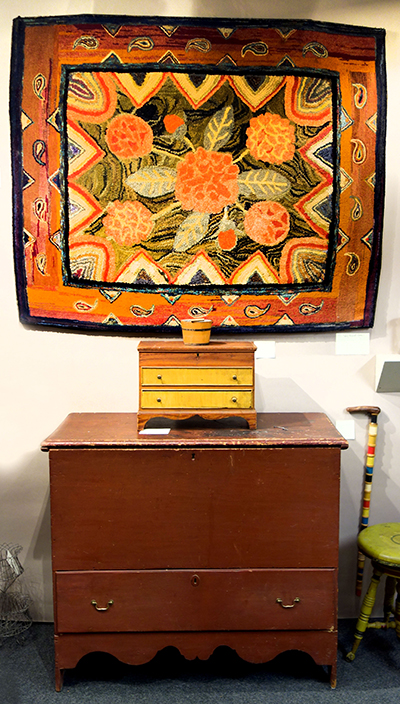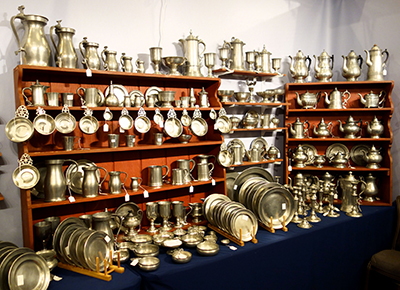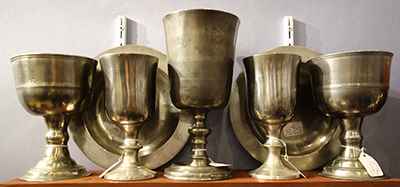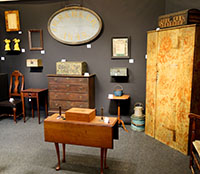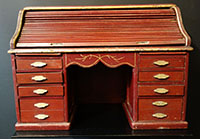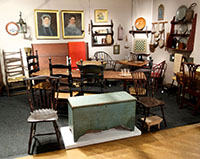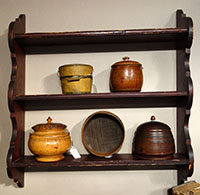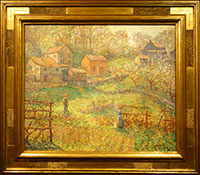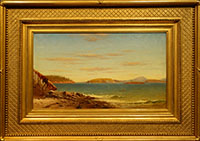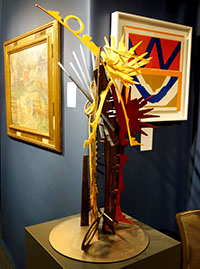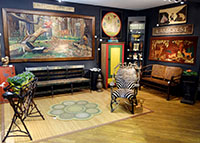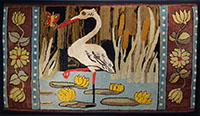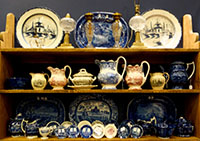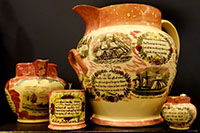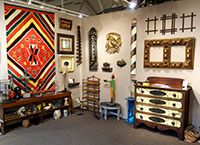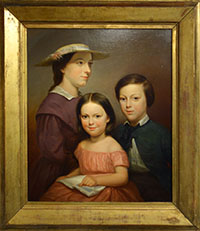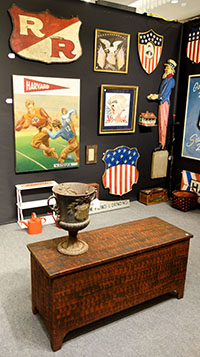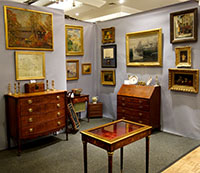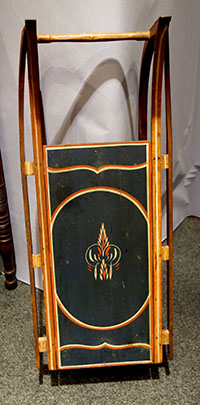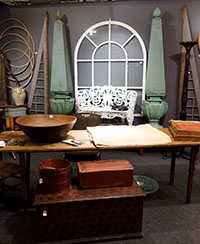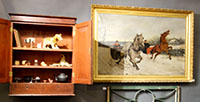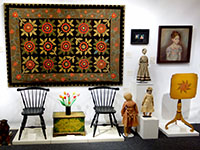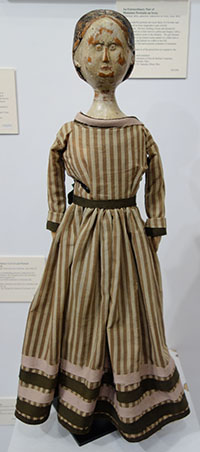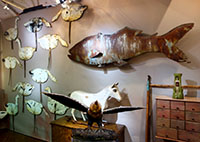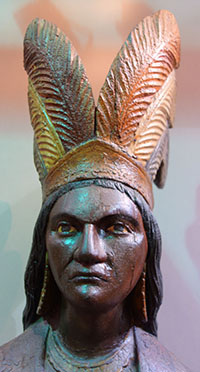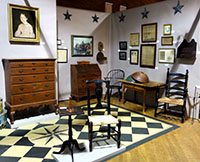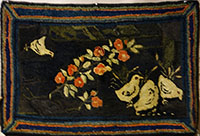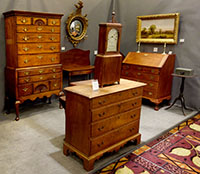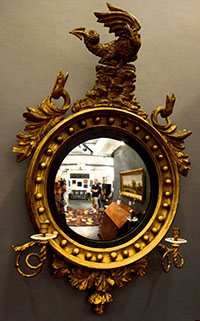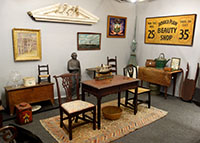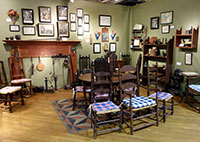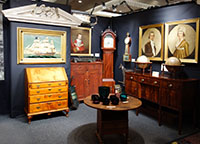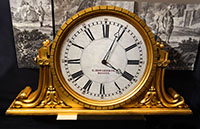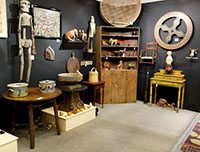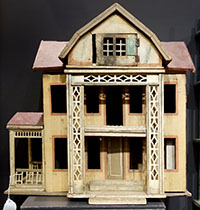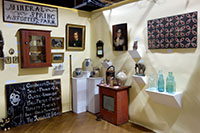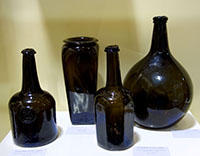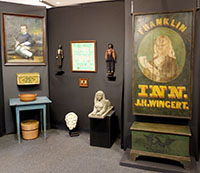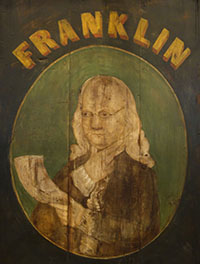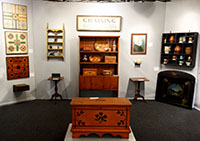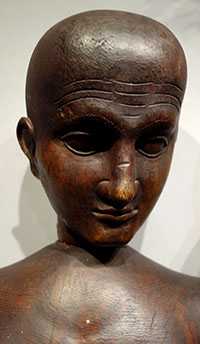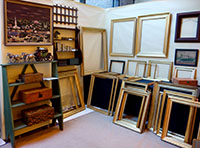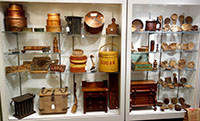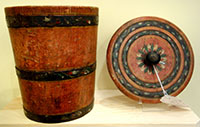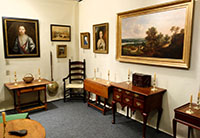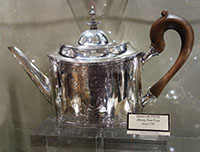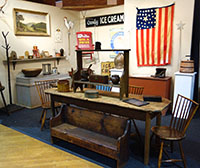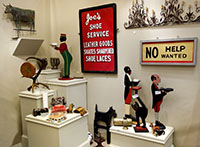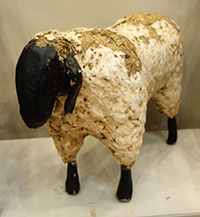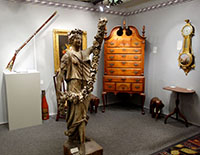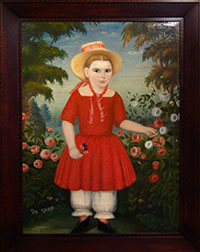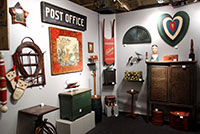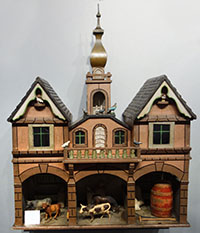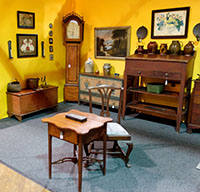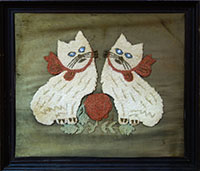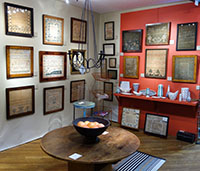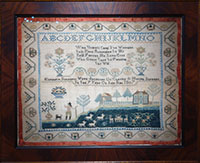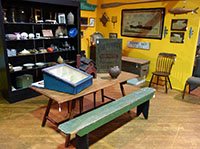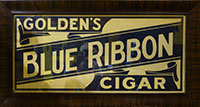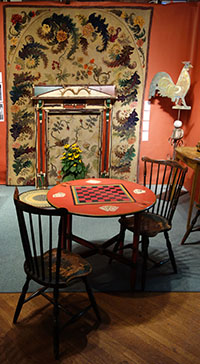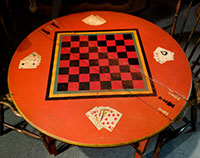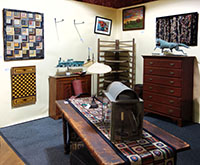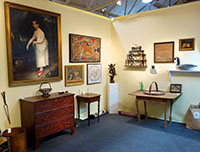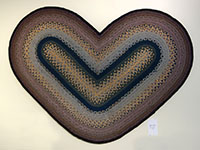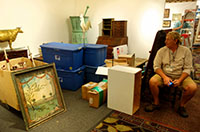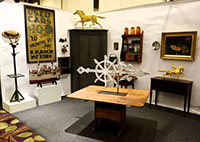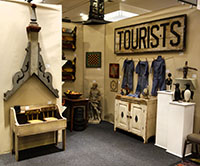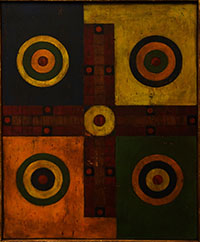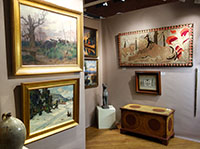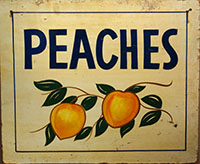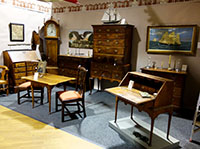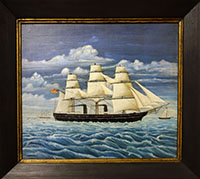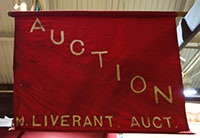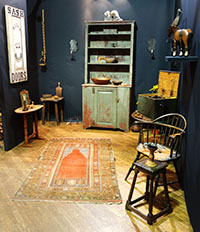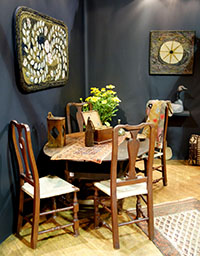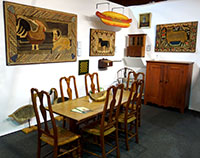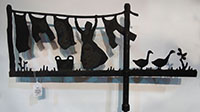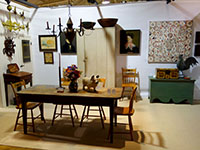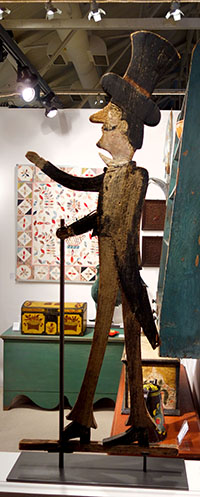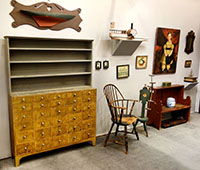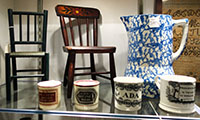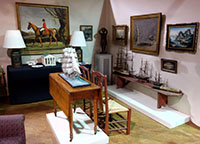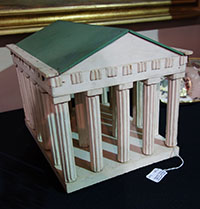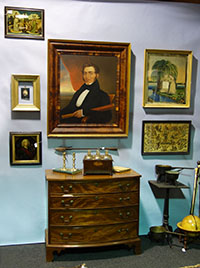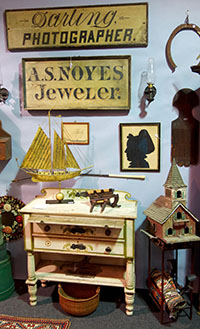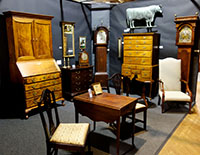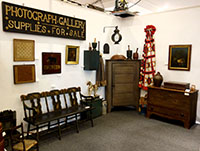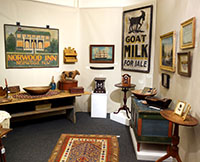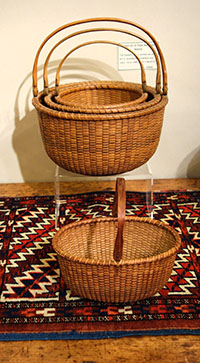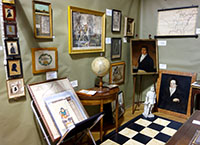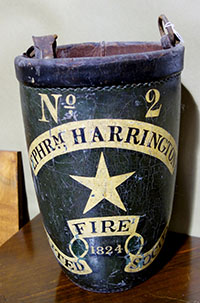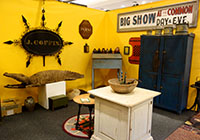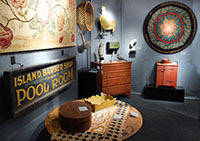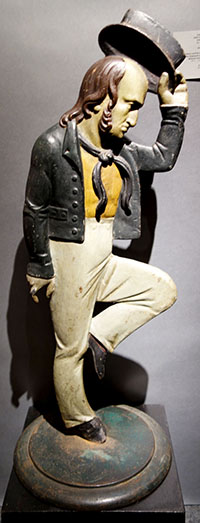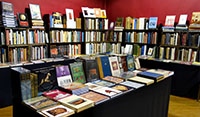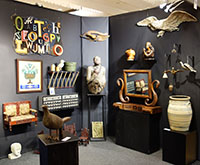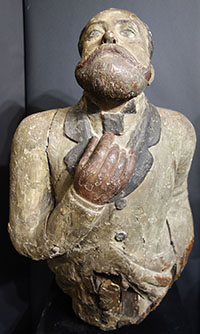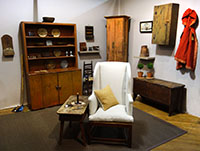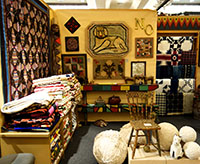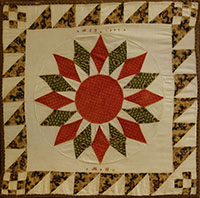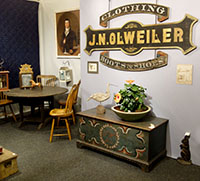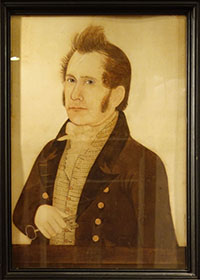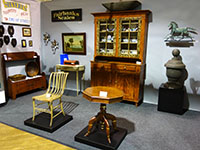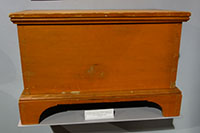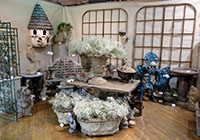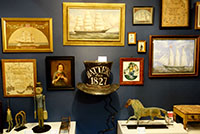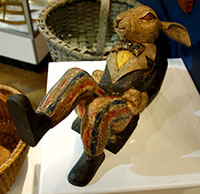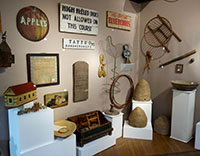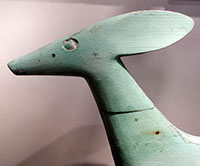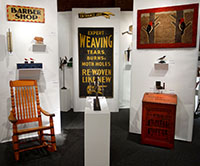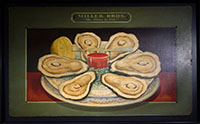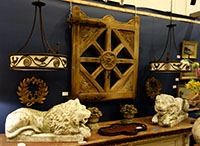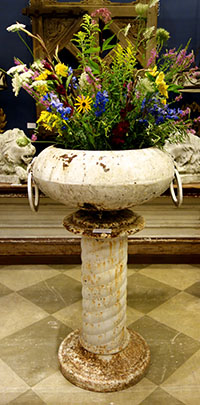Review and Photos by R. Scudder Smith
MANCHESTER, N.H. — Wow! The New Hampshire Antiques Show just keeps getting better. So seldom does a year go by when you cannot say that, but on this 58th anniversary of the show it is more than well deserved. Everything seemed to be going right, including on-time setup at the Radisson, exceptional inventories, record-setting attendance not only for the first day, but also for the run of the show, and wonderful sales, which caused a shortage of “sold” tickets for some of the dealers. According to Michael Sczerzen, floor manager, more than 1,000 people came into the show before noon on Thursday, August 6, with a grand total of exceeding 1,400 by the end of the day. And attendance records were set on each of the two following days.
It is no wonder that this show, along with a trio of close-by antiques shows the same week, combine to make this the most anticipated antiques happening in the country. People come from near and far, meeting up yearly with friends and other collectors, to reap some of the finest pieces to come on the market. And more than one dealer will tell you that “We save things all year long to offer during Antiques Week in New Hampshire.”
Steven Still about said it all in his ad in the show section that appeared in the July 31 issue of this paper. It read, “We will be letting the cats out of the bag on August 6th,” printed above two closely tied bags, and, boy, did that happen — not only with Steven, but at booth after booth.
What came out of Steven’s bags and filled his booth was a folk art walnut and ash burl shoe table with a 26-inch-wide and 1½-inch-thick ash burl plank for the top. This table, with human-shaped legs, was found in New Jersey and dates from the second half of the Nineteenth Century. Also at the front of the booth was a Samuel Gragg patent “Elastic” chair, patent date 1808, Boston origin with the original painted surface. A pine bucket bench in old red, Pennsylvania, dated from the mid-Nineteenth Century, and a Santa roly-poly, excellent condition, was an eye-catcher in the glass case.
Across the aisle, Gail and Don Piatt, Contoocook, N.H., offered a chest on frame from southern New Hampshire, all original and dating from the second quarter of the Nineteenth Century, and a small dry sink with one door, taken down to a warm bittersweet red. A child’s chest with four graduated drawers and bracket base was in old red, and a Noah’s Ark stable was filled with many different pairs of animals.
Frank and Barbara Pollack American Antiques & Art, Sunapee, N.H., and Highland Park, Ill., showed a fine pair of low back, fanback Windsor side chairs from south central New Hampshire. The chairs were of maple, pine, ash and hickory, circa 1795–1805, with old green painted surface, and a carved man’s head on top of a “whimsy” staff measuring 36 inches long. A pair of tenth anniversary tin high button shoes, American, circa 1880, measured 9½ inches tall. Early on opening day Barbara sold her wonderful large green gathering basket with the hoop handle, among other sales.
“The show was excellent, and I wrote more sales slips than ever,” Peter Sawyer, Exeter, N.H., said. He added, “I have made a list of my sales and remember, add an ‘S’ to each category.” His list included paintings, bureaus, one-drawer stands, candlestands, clocks, including a tall case clock and a dwarf clock, and two pairs of chairs. The rare dwarf clock was probably South Shore, Mass., circa 1820, in bird’s-eye maple case in the original finish, and a Chippendale secretary desk, New Hampshire, circa 1800, was found in Concord. A Federal four-drawer bureau, circa 1810, was from Middlebury, Vt., and retained its original finish and brasses. “I have adjusted to a new pricing structure, more realistic and in tune with the time, and it is working out well,” Peter added.
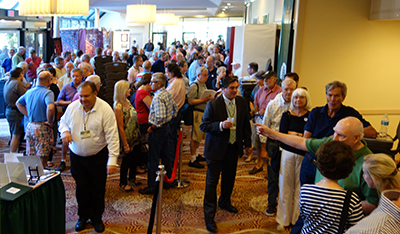
When the lobby adjoining the show floor was filled, the line of visitors extended outside and went down the block past the back parking lot.
A weathered scarecrow, in the form of a jointed skeleton, with traces of the original paint, hung against the back wall at Jef & Terri Steingrebe’s booth, and on a side wall was a large game wheel with an interesting central design and three rows of dice around the outside edge. These Springfield, N.H., dealers also offered a grain painted dressing table, two short drawers over one long drawer, and a stagecoach doorstop with two horses.
“We had a very good show; people came and stayed for longer than usual, and sales were strong,” Stephen Corrigan of Stephen-Douglas of Rockingham, Vt., and Walpole, N.H., said. He noted that sales included the “J.N. Olweiler, Clothing, Boots & Shoes” trade sign, a large standing horse weathervane, a Liverpool jug with John Adams pictured, a child’s Windsor chair, a scrimshawed tooth, painted bucket, baskets, mocha, woodenware and some fabrics. The booth was not heavy with furniture, only a few pieces, including a Nineteenth Century shoe foot chair table, a set of four painted stepdown Windsor side chairs and a Matteson-decorated two-drawer Vermont blanket chest.
Centered in the booth of Withington & Co., Portsmouth, N.H., was a tall cast iron urn with a round pot on top and rope-turned base. It was originally from Ohio, circa 1970, and on the back wall was a sturdy wood gate with the original hardware, Staten Island origin, circa 1880. A pair of cast iron reclining lions, old white painted and weathered surface, dated circa 1900.
“I have chased that sign for about 20 years, and finally got it,” Tom Longacre of Marlborough, N.H., said pointing out a sign for “Miller Bros — The Place To Eat” that came from a restaurant in Baltimore that was in operation from 1913 to 1963. Against a green ground was pictured a plate of six oysters with a lemon and fork in the center of the plate. Tom has a full printed history of the restaurant, a place on Fayette Street known to cater to politicians and show people. Selling was brisk again this year for Tom, who gave a partial list of sales that included a small wood-carved pig, a carved wooden hand pointing trade sign, a large Cushing & White copper apothecary trade sign, a set of six decorated Windsor side chairs, a four-drawer spice cabinet in cobalt blue paint, needlework theorem, an American Nineteenth Century wooly with a ship flying an American flag, five weathervanes — including a sheet metal figure of Gabriel, ex Bernard Barenholtz collection, and a small full-bodied fish — and a Hepplewhite tapered leg stand. “This year I gave Bev only a small area of my booth to sell her Christmas things, and she did very well,” Tom said. Sales included a variety of ornaments, feather trees and a fine knitted stocking with all manner of holiday decorations in the design.
John Chaski, Camden, Del., had two carved pine articulated artist’s mannequins seated in his booth, one measuring 68 inches tall, the other only 45 inches tall, both of French origin and dating circa 1800–1850. A New England pine wall cupboard from the early Nineteenth Century had open shelves and storage behind a single door, and held a number of smalls, including a few slip decorated pieces of redware and painted document boxes.
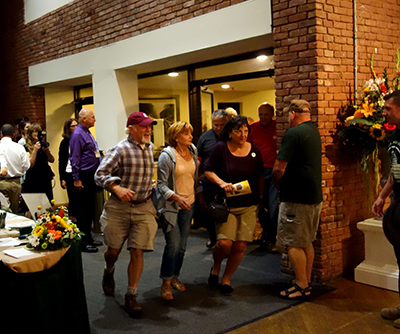
First in line, first into the show, and on the run. Scott Cook began the line at 2:45 am, just over seven hours before the opening.
Paul J. DeCoste, West Newbury, Mass., had a very full booth and things of many interests, including a two-masted ship weathervane with gilded surface, a large sailor’s valentine with hearts in the center, a series of mocha pitchers in different patterns and sizes, four nice redware apple banks and a sign from the Danvers Fire Hose #4 for a Major Chase, with fancy iron work ending in a heart on the top of the piece.
“It was really very heartening to see such selling going on,” Judy Milne said as the show was winding down on Saturday afternoon, adding, “We had a better show than last year, and everyone seems to be happy.” Judy and husband James operate from their shop, At Home Antiques, Kingston, N.Y., and are known for weathervanes, country furniture and folk art. “We were able to buy seven banner weathervanes out of one collection recently, and sold six of them at the show,” Judy said. Other sales included a large standing horse vane, wood with white surface, a hooked rug with horses, several large signs, including one that read “Home Dining Room,” and a store counter that once belonged to the late Corrine Burke, a former dealer and part-time show manager. Other furniture sold included a blanket chest and dough box.
An interesting and colorful table was shown at the front of the booth of American Classics, Meryl Weiss, Canaan, N.H., a round, circa 1930, drop leaf with a bright orange top, and paint decorated with a checkerboard in the center and four hands of cards around the edge. Drawn up to the table were three painted Windsor side chairs with shell motif ears, circa 1760, and all original.
A collection of child’s chairs hung on the outside wall at Nathan Liverant and Son, Colchester, Conn., and a red flag with lettering noting “N. Liverant — Auction” hung off the front of the booth. “We found the sign among some of my uncle’s things and it once belonged to my grandfather,” Arthur Liverant said. Among the furniture in the booth was a Queen Anne desk on frame, east Connecticut or Rhode Island, circa 1745–1770, and a Queen Anne maple porringer top table featuring a cyma curve scrolled apron. Written in chalk on the underside was “Mrs J.W. Wheeler,” a Rhode Island or Connecticut piece, dating circa 1745–1770. A signed and dated portrait of a gentleman, Frederick Mayhew of Martha’s Vineyard and Ohio, 1853, was on a tulip poplar panel.
Well lit and neatly arranged was the display of Jeff & Holly Noordsy Antiques, Cornwall, Vt., with a fanciful late Nineteenth Century table mat, New England, centered on the back wall, and a wonderful, delicate paint decorated document box, New England, probably Woodstock, Vt., circa 1830, on the same wall. Among the numerous pieces of glass shown were three large globular bottles, two of them dating circa 1810 from Pittsburgh, the third circa 1845, Suncook, N.H.
John H. Rogers Antiques, New London, N.H., brought only half a case of butter stamps, just a fraction of his collection, but he varied the designs with animals, flowers and hearts. A New York State maple scoop had an Indian effigy handle, and a large firkin sported a yellow surface with red letters reading “Sugar.” A cherry dressing table with maple drawer fronts, original glass knobs, had two short drawers over one long drawer.
According to some dealers, good trade signs are hot items these days and if so, Douglas Wyant of Cassopolis, Mich., was there to please buyers. His walls were draped in signage, including one reading “Liar’s Bench” and picturing a large fish on board, while across the booth ice cream sundaes were advertised as “Good, Refreshing, Delicious! — 20/25/30 cents.” A sundae, with red cherry on top, was pictured in the center. An oil on canvas by V. Struck featured Harvard Football, depicting a player in full uniform, with football, racing for the goal posts.
A circa 1890 Pennsylvania schoolhouse quilt, with 25 of the same model house but all in different colored fabrics, brought lots of color into the booth of Axtell Antiques, Deposit, N.Y. Adding more color was a Schoharie County, N.Y., blanket chest, circa 1820, paint decorated on a blue ground. A drop leaf tavern table, dating from the Eighteenth Century, birch with an unusual double “H” stretcher, old red surface, was from New Hampshire. A lineup of seven candle molds, varying from one tube to 18, was shown with a quartet of tall hogscraper candlesticks, all with wedding bands.
Jewett-Berdan of Newcastle, Maine, moved to a larger and more visible booth this year, and great business followed them. “We wrote just over 50 slips,” Tom Jewett said, including one for my most favorite thing, a very rare paper cut and watercolor scene with 40 figures in it and signed by Emily Potts, 1843. Other sales included a portrait of a Mr Wilson, once owned by Mary Allis, two early painted trade signs, a nest of three painted mini Hingham oval boxes, a large, colorful theorem on velvet, circa 1830, of fruit in a bowl and several folk art miniature portraits. An African American doll with the original clothing, a Maine banner weathervane and a circa 1835 miniature blanket chest, 9½ inches long, also sold, as did the early Nineteenth Century presentation board, chip carved in cherry and maintaining the original surface. “Butch” Berdan added that “with so many shows at the same time, this is really the Americana Week of the year,” noting, “We are already buying and saving things for next year.”
Kelly Kinzle, New Oxford, Penn., was new to the show this year and brought a large carved figure of Spring, American, dating from the last quarter of the Nineteenth Century. Of pine and retaining traces of the original paint, it measured 78 inches tall and was from a commercial building in Beacon, Dutchess County, N.Y. A long rifle, Jacob Young (1774–1842), Sumner County, Tenn., circa 1815, measured 63½ inches long and was of maple, steel, brass, hickory, silver and white and yellow gold. A large pair of carved arched panels in cherry, circa 1816, was found in Shenandoah County, Va., each measuring 64 inches high and 22 inches wide. Possibly they were used flanking a stage, and each retains traces of the original paint.
Pewter & Wood Antiques, Enfield, N.H., also new to the show, offered a selection of three large churns, one of triangular shape with old blue painted surface. It was found in Maine and dated from the Nineteenth Century. A small size corner cupboard, with one door, circa 1840, was in old green paint, and a Schoharie County bible box, circa 1870, was of pine with the original urn with flowers design on top.
In the corner of a large booth, Joshua and Mary Steenburgh, Pike, N.H., hung a carnival weight chair with a sign inviting people to sit down and have their weight guessed. If you fooled the guesser by not being within three pounds of your actual weight, then you won a prize. Two signs, possibly from the same carnival, encouraged people to buy ice cream sodas, and a row of nine demijohns, free-blown bottles, was arranged in graduated order. At the back of the booth was a pair of fraternal star-topped shafts flanking an American flag with an odd pattern of stars. “We sold all three days and had the best New Hampshire ever, and we have been doing it for eight years,” Joshua said. Among his sales he listed signs and paintings, a large wooden bee skep, a blanket chest in blue paint, a child’s settle and a large cow weathervane. When asked if he was going to co-chair the show for another year, he gave a quick “Yes,” adding, “But only if Bev Longacre and Tommy Thompson carry on.” And they all have agreed to do so.
“The New Hampshire Show is a one-of-a-kind environment, full of energy, and customers come to the show knowing what to expect,” Russ Goldberger of RJG Antiques, Rye, N.H., said. He also noted that “the show looked its best ever and many of the dealers are already preparing for 2016.” He reported good sales, including game boards, weathervanes, a hooked rug, miniature carved waterfowl, trade signs, a child’s cupboard and a large seafood sign advertising ten specials including “Scallops,” “Bluefish,” “Clams” and “Quahaugs.” One of his favorite pieces in the booth, which did not sell, was a cast iron ship chandlery shop sign, American, circa 1870–1880, 23 inches tall and in the original paint. It featured the figure of a sailor. In addition to four decoys shows, this is the only antiques show, at present, where Russ and Karen exhibit.
“We had a great show, fabulous,” Michael Seward of Pittsford, Vt., said, speaking for himself and Lucinda, and then turned the phone over to his better half to give the details. Lucinda remembered most of the sales, including the first one on Thursday, a marble statue of a girl measuring about 4 feet tall. She continued, listing four samplers, a Queen Anne table, large-size braided rug, paint decorated blanket chest, several carved wooden birds, two wallpaper boxes, three painted bowls, a Black Hawk weathervane with great surface and the portrait shown in their ad, a young girl in blue dress, white collar, holding several pieces of fruit.
Pam and Martha Boynton, Groton, Mass., again shared a booth, offering an apothecary chest from a doctor’s office in New Hampshire, a carved and painted ship plaque, skating lanterns with blue, green and red shades, a large carved wood watch repairing trade sign and a pair of portraits of a young couple from Maine.
Furniture filled the booth of Gary T. Yeaton, Concord, N.H., including a Chippendale oxbow slant lid desk, Newburyport, Mass., in mahogany with claw and ball feet and the original brasses. A New England Queen Anne high chest, circa 1780, had carved fans, shaped apron and the original brasses.
A large wood-carved hat, painted black and lettered “Hatters Since 1827” on the front, a milliner’s trade sign from Westchester, N.Y., was centered in the booth of The Norwoods’ Spirit of America, Timonium, Md., and Doug Norwood was quick to point out the stand for the hat. “We have a clever stand maker and for the hat, instead of using just a straight rod, he fashioned an image of Lincoln under the hat to make it more interesting,” Doug said. As usual, there was little space left on the walls after everything was hung in place, including a large theorem on velvet of a bowl of fruit, with a melon and knife right in the center. Nearby was a large paint decorated and wax-coated papier mache watermelon that was once a trade sign for a fruit market.
A wood-carved deer weathervane from Friendship, Maine, with panted verdigris surface, was sold opening day from the booth of Thomas Thompson, Pembroke, N.H., and one of the four bee skeps displayed also had a sold ticket. A large selection of stone fruit was piled in a wooden bowl, and a set of oversized dominos filled a good portion of a display case.
A smoke decorated country Hepplewhite New England chest, probably New Hampshire, circa 1820–1835, was shown by Douglas Solliday, Columbia, Mo., along with a triple portrait of youngsters, an oil on canvas dating circa 1850–1860, and a circa 1880 painted wood gate.
The booth walls were covered with samplers at M. Finkel & Daughter, Philadelphia, with an important Salem, Mass., example by Peggy Silver, dated 1797, centered on the back wall. This sampler had both verse and alphabet and was enclosed by a very decorative floral and vine design. A New England center table with column base, white painted, early Twentieth Century, and a large-size steer head shop sign, painted gold and dating from the early Twentieth Century, American, were shown against the outside end wall.
A dapper man with top hat and tails, an American cut out pine and painted figure from the late Nineteenth or early Twentieth Century, 64½ inches tall, stood at the end of the booth of Olde Hope Antiques, New Hope, Penn., looking as if he were in charge of the entire booth. From where he stood he overlooked a Pennsylvania farm table, circa 1840, with square tapering legs, two-board top, and blue/gray painted base, over which hung a seven-arm Pennsylvania German chandelier, tinned sheet iron with punched hearts and tulips, 32 inches in diameter, circa 1820–1840. A horse and sulky weathervane was shown at the opposite end of the booth, and was marked “sold” shortly after the show opened. Also sold was a pair of tin sconces and a pair of early portraits, among a good number of other pieces.
A large pair of scissors, formerly a trade sign, was centered in the booth of American Garage, Los Angeles, and against the back wall stood two racks of shooting gallery cast iron targets, ten rows high and ten targets per row. A wine and liquors trade sign featured a beer glass in the center and wood columns on each side, and four wood-carved hands with hearts were mounted on long posts at the front of the booth.
A large woodland fauna and flora painting filled most of the back wall at Cherry Gallery, Damariscotta, Maine, and a hand painted sign pointed the way to “Camp Wick-I-Up.” A red circle on a black background hooked rug enclosed a pair of rabbits, along with some birds and flowers, and a very colorful set of ten knock-down pins, with a slide top box, sold about as the show opened.
You might think that on Sunday, the day after a busy three-day show has closed, dealers might just be resting up for the next one or doing easy chores about the house. We did not expect to reach Sharon Platt already on the go again and busy previewing the coming Bill Smith auction. However, she did take time for a few words and agreed that her booth, after only a couple of hours, looked as if someone had just randomly thrown a handful of red dots in her direction, a colorful indication that things were going well for this Portsmouth, N.H., exhibitor. Catching attention was an Eighteenth Century lady’s cloak, felted wool dyed red, and standing against the back wall was an Eighteenth Century rare form chimney cupboard in the original salmon paint, 6 feet 10 inches high, and possibly the work of a clock case maker. Both of those things sold, as did an Eighteenth Century hanging cupboard with tombstone door, an Eighteenth Century pine tankard, a large Roger Bacon treen plate, an Eighteenth Century wing chair with the original leather seat and a hanging cupboard in red paint, among a number of other objects. “The first hour was amazing, it was great fun, and it all ended up much better than last year,” Sharon said.
Michael Whittemore Antiques & Folk Art, Punta Gorda, Fla., offered a fine New Jersey corner cupboard, painted, circa 1790–1810, with two doors over a single door in the lower section, and an early Nineteenth Century whale-end shelf in old red. A Queen Anne tea table with oval top, eastern Connecticut, circa 1760–1780, was in all original condition, and a selection of weathervanes included a rooster, steer, cow, standing horse, running horse and horse with rider. “I had a wonderful show and kept replacing sold items with things from the truck to keep the booth fresh,” Michael said.
Jonathan Trace, Portsmouth, N.H., had a William and Mary tavern table, New England, circa 1750, and a slat back Hudson Valley armchair with rush seat, 1730–1750. Centered in one of the silver cases was an Isaac Hutton, Albany, N.Y., tea pot, circa 1795, and a William Simpkins tankard, Boston, 1750.
A Queen Anne walnut inlaid slant lid desk, Maryland or Rhode Island, dated circa 1740–1760, and an American Chippendale oxbow chest in mahogany, Massachusetts, circa 1760–1780, was shown by Ed Weissman, Naples, Fla. Shown on a card table was a Japanese porcelain “Black Ship Bowl,” Eighteenth Century, 11½ inches in diameter.
Pratt’s Antiques, Victor, N.Y., had a nice early inn sign from the Norwood Inn, Norwood, N.Y., oil on galvanized tin with an iron band all around, circa 1920–1930, and a country store desk in two parts, painted and from the Cooperstown area, circa 1820–1830, in cherry with red surface and measuring 70 inches tall.
Dennis & Dad, Fitzwilliam, N.H., filled cases, shelves and tables with all kind of mocha pieces, Staffordshire, historical blue, Canton, Bennington and an early English puzzle jug with sunburst and floral decoration, 11 inches high, and a large, handled Sunderland pottery jug with 11 transfer scenes, circa 1820, 11¾ inches high.
“We generally do a show in Santa Fe during August, but when we were invited to join the New Hampshire Antiques Show, our plans changed and we came east,” Tim Chambers of Missouri Plain Folk, Sikeston, Mo., said, “and we had an excellent show.” Tim noted that sales ranged from top to bottom, including six game boards and a special New Hampshire paint decorated box with flags on the top. “We really did not know what to expect, but it was great. Wonderful dealers, visitors and things to buy,” Tim said.
Few people, if any, would disagree with Tim Chambers and many of the people leaving the show parted with “See you next year.” So jot down the dates, August 11–13, for the 59th edition of the New Hampshire Antiques Show.
Photo Gallery
Please click any photo to enlarge.

